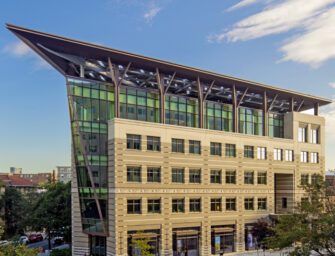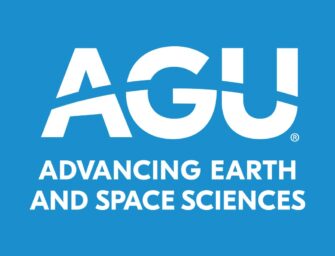Board Action: 2017-2018 Fall Meeting Locations
UPDATE: As a result of scheduling issues, the Board of Directors decision on the potential change in location for the 2017 and 2018 Fall Meetings has been delayed until later in February. The results of that vote – as well as the results of the member/attendee survey that was conducted to help inform their decision – will be published by the end of the month.
By Margaret Leinen, President, American Geophysical Union; Eric Davidson, President-elect, American Geophysical Union; and Chris McEntee, Executive Director/CEO, American Geophysical Union
As the 48th year of AGU’s Fall Meeting gets underway, we want to update you about an important issue that was discussed by both the AGU Board of Directors and Council and voted on during yesterday’s Board of Directors meeting: the need to consider alternative locations for the Fall Meeting starting in 2017 as a result of construction taking place in San Francisco.
Whether this is your first Fall Meeting or your 48th, you no doubt have recognized that AGU’s primary goal in holding this important gathering is to advance Earth and space science. The quantity and quality of space for presentations, posters, networking and discussions, high profile keynote and named lectures, and the availability of auxiliary events throughout the week, as well as the ability to engage with the program virtually through AGU On Demand, etc., all contribute greatly to the achievement of that goal. We work very hard to ensure that those events are able to meet the growing and changing needs of our community; and, whether it’s the ease with which you can get to and move about within the city, the timing of the meeting or the local amenities, we also work hard to ensure that you, our attendees, have the highest quality experience possible.
Those of you who are attending the Fall Meeting this year will quickly see, the Moscone Center here in San Francisco is undergoing substantial renovations (temporary walls and structures, increased congestion, and impeded pedestrian flow and traffic). These renovations, which are only now in their beginning phase, are part of a multi-year plan to expand the conference facilities. In 2017, the impact will be even clearer. AGU would lose meeting room space, resulting in fewer sessions and lectures, and requiring us to move hundreds of presentations to hotels across the city. General session spaces would be in short supply, and registration space and hallways generally would be smaller, leading to overcrowding. While the construction is scheduled to be complete two weeks prior to AGU’s 2018 meeting, big projects often aren’t completed on time, which could result in continuing limitations to the meeting and inconvenience to attendees.
We are pleased to see these upgrades happening, but we have also come to realize that the intensive construction that will take place in 2017 and 2018 poses a clear risk to the quality and diversity of the Fall Meeting’s scientific programming, not to mention our ability to provide you with the networking opportunities and – quite frankly – space we know you want. (You will notice construction impacts in 2016, but we are doing everything we can to ensure that the impact to your experience and our ability to advance the Earth and space sciences is manageable.) Not only does this represent a major inconvenience for you, our attendees, but it also poses a significant barrier to our ability to advance Earth and space science through the Fall Meeting programming.
This situation could result in a significant change and we do not take that change lightly. At the same time, it does allow us to ponder the possibilities that different locations may provide an opportunity to begin to experiment with the meeting in ways that many attendees have suggested in the past. Whether that meeting takes place in a different location or stays in San Francisco, you can be assured that we are doing everything possible to ensure that it aligns with our mission and values as a scientific society.
To help further inform the decision-making process, we are asking you to participate in a short survey about the types of things we should consider when making our decision about the 2017-2018 meeting location/locations. The survey will be open until 8 January, and you are strongly encouraged to share your insights and preferences.
As always, we thank you for your commitment to AGU and to the Earth and space sciences . . . and we look forward to finding new and exciting ways to help advance Earth and space science through Fall Meeting programming and content.




PLEASE keep the meetings in San Francisco!
Please move the meeting for at least these two years. Honestly, there are other good options, we don’t need to be fixated on San Francisco, this conference would suffer a tremendous loss of energy and enthusiasm if everything were spread over a bunch of hotels..
San Francisco is not Mecca–there are plenty of other acceptable locales that would be able to accommodate the AGU meeting with hotels and meeting space that is amenable to facilitate good networking (which I suspect is the primary goal of attendees) San Francisco seems to have become a “default” location for AGU planners–perhaps due to the ease of having it in the same place each year. I used to sponsor an anuuAL scientific program review and, while it is more work for the planners–it is also more exciting for the ATTENDESS TO TRAVEL TO NEW LOCATIONS EACH YEAR (OR EVERY TWO YEARS) NOTE THE SSA HAS ITS MEETING IN A NEW LOCATION EACH YEAR.
Some of us international attendees have budget limits for lodging reimbursement: San Francisco, New York, and Los Angeles are under a higher limit, end everywhere else in the USA is under another, lower one, which is well below the average cost of hotels in places like downtown Denver, for example. In Denver I am left out of pocket by about $50-60 per night when attending GSA meetings. San Francisco is also one of the few places that has regular direct flights from my city, and that has a real public transport system. The last thing I would want is have to rent a car, or pay for expensive shuttles and taxis to get around. For example, Baltimore is a nightmare to reach from most cities in Europe (as it would be any other place served by Washington IAD) – and hotels are not any cheaper than in San Francisco. It would be fine to relocate the meeting for a couple of years, rather than dealing with reduced spaces, but in the long run I do not think that most other US cities would be a viable option for this meeting. If the meeting were to relocate I would be better off going to EGU in Vienna, where more and more people have started attending. In fact, EGU used to move around, until they figured out that a convenient, fixed location makes the meeting experience so much better, as logistics can be fine-tuned. Take GSA, for example, where there are so many glitches due to the “moving around” policy that it is a nightmare for attendees more often than not (presentations not running properly, awful technical support for most things related to the scientific program, sky-high hotel prices in many locations, 3-hour trips from nearest international airport, unsafe locations, and not even a viable coffee place inside the conference center). As an international participant, my average cost of attending GSA meetings has also been so far consistently about $800-1000 higher than the Fall AGU meeting, and I have attended several of both in the past 10 years. The higher price is a combination of higher hotel prices in the cities selected, and higher transportation costs due to either distance to nearest large international airport, or to expensive routing due to limited selection of carriers (i.e. routes with no competition). The latter is the case for all those cities that are not the common tourist destinations from Europe (New York, Boston and Miami on the east coast, San Francisco and Los Angeles on the west coast).
I am thinking Orlando in early december. The city is empty — no vacations then. Big convention center, and reasonable cost. Alternatively, how about DC?
The issue is probably a bit more tricky than the average member realizes. There are about 20 centers in the US that are bigger than Moscone. But I think the 2 in Nevada are out because US federal employees cannot stay at casino hotels, I am told. Let’s assume that most of the NE US sites are less desirable – Chicago, Pittsburgh, Boston, Cleveland, for weather reasons; there are several sites that might be of interest but have issues wrt flights- San Diego has very few direct flights internationally due to its small airport, but could be good; New Orleans could be good, but the airport is at the end of the rope, so everyone has to connect from Atlanta, Dallas, Chicago, etc. So, then the list gets pretty small. Some AGUers are really into the “vibe” of sfo – restaurants, drinking at the bars, etc., and AGU 2017-2018 might have to settle for Orlando, or Anaheim, or Dallas? All of which are decidely not the usual AGU vibe. But there are worse things in life than not being able to drink in some fou fou bar off Union ….
Las Vegas: I’ve gone to a number of SEG meetings there. Good prices for nice hotels. Lots of flights. And you can go hiking in Death Valley.
I think it would increase visibility and exchange between attendees if those two years are used to go abroad, e.g. East-Asia and Europe. Traveling and prices are in most countries similar…
Seattle and Vancouver are possibilities to consider. Good international connections, relatively mild winter conditions for northern cities, lots of conference space, good public transportation especially Vancouver, and each with a “vibe” of its own.
Putting the *AMERICAN* Geophysical Union meeting outside the USA is completely untenable. The question is where inside the USA to go. Fall AGU has drawn a lot of Asian participation in part due to the proximity. This is a good thing. But participation by Europeans has been slower to rise for the opposite reason. So to expand the meeting and for the sake of fairness, it should be on the eastern half, not Seattle or Las Vegas. Northeast is too cold and prone to snow. Orlando, Atlanta, New Orleans are all good options. Atlanta has world’s busiest airport so easy for anyone to reach, and yes it has a “vibe”, too.
[…] we notified you last December, the Moscone Center’s renovation plans pose a significant risk to our ability to deliver a […]